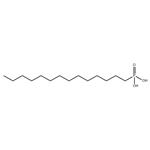N-TETRADECYLPHOSPHONIC ACID is a white to off-white powder.
Room Temperature; may vary elsewhere.
1-Tetradecylphosphonic acid is used to functionalize the surface of BaTiO3 nanoparticles.
TDPA can be used to cap copper nanoparticles to protect them from oxidation. It may also be used in the synthesis of cadmium sulfate (CdS) core, which can be used in the fabrication of cadmium selenium (CdSe)/CdS core quantum dots (QDs). It may also be coated on caesium lead bromide (CsPbBr3) perovskite quantum dots for the development of white light emitting diodes (wLED).
Tetradecylphosphonic acid forms a self-assembled monolayer (SAM) to functionalize a variety of nanoparticles.
tetradecyl phosphonate is a pan-antagonist of lysophosphatidic acid 1 (lpa1), lpa2, and lpa3 receptors. the ic50 value for inhibition of lpa-induced calcium mobilization was 10 μm, 5.5 μm, and 3.1 μm, respectively. at a concentration of 10 μm, tetradecyl phosphonate activates a peroxisome proliferator-activated receptor γ reporter construct 4-fold when compared with the controls and partially inhibits autotaxin with an ic50 value of approximately 3 μm [1].lysophosphatidic acid (lpa), also known as autotaxin (atx), is a lipid signalling molecule formed by the hydrolysis of lysophosphatidyl choline by lysophospholipase d [2]. lpa signals through four different g protein-coupled receptors, named as lpa1/edg-2, lpa2/edg-4, lpa3/edg-7, and lpa4/gpr23 [3]. it has been reported that lpa was involved in activating peroxisome proliferator-activated receptor γ (pparγ) [4].
[1]. durgam g g, virag t, walker m d, et al. synthesis, structure activity relationships, and biological evaluation of fatty alcohol phosphates as lysophosphatidic acid receptor ligands, activators of pparγ, and inhibitors of autotaxin[j]. journal of medicinal chemistry, 2005, 48(15): 4919-4930.
[2]. tokumura a, majima e, kariya y, et al. identification of human plasma lysophospholipase d, a lysophosphatidic acid-producing enzyme, as autotaxin, a multifunctional phosphodiesterase[j]. journal of biological chemistry, 2002, 277(42): 39436-39442.
[3]. noguchi k, ishii s, shimizu t. identification of p2y9/gpr23 as a novel g protein-coupled receptor for lysophosphatidic acid, structurally distant from the edg family[j]. journal of biological chemistry, 2003, 278(28): 25600-25606.
[4]. mcintyre t m, pontsler a v, silva a r, et al. identification of an intracellular receptor for lysophosphatidic acid (lpa): lpa is a transcellular pparγ agonist[j]. proceedings of the national academy of sciences, 2003, 100(1): 131-136.


